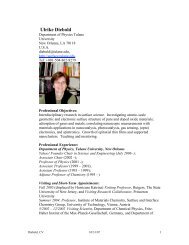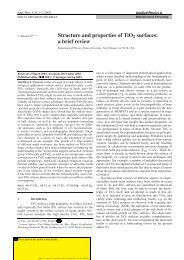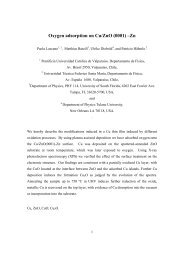The surface science of titanium dioxide - Niser
The surface science of titanium dioxide - Niser
The surface science of titanium dioxide - Niser
You also want an ePaper? Increase the reach of your titles
YUMPU automatically turns print PDFs into web optimized ePapers that Google loves.
84 U. Diebold / Surface Science Reports 48 (2003) 53±229<br />
2.2.1.4.3. Oxygen vacancies created by other means. Oxygen vacancies can also be created by<br />
bombardment with electrons. TiO 2 is the classic example for a maximum-valencycompound<br />
material where electron-stimulated desorption occurs via the Knotek±Feibelman process [135].<br />
Bombardment with energetic electrons creates a core hole in the Ti3p level. With a certain<br />
probability, this hole is filled through an inter-atomic Auger process from a neighboring O atom. If<br />
two (instead <strong>of</strong> the usual one) valence electrons are emitted during the Auger decay, the oxygen anion<br />
becomes positivelycharged. <strong>The</strong> previouslyattractive Madelung potential changes into a repulsive one,<br />
and an O ‡ ion is emitted [136]. This process has a threshold energythat correlates with, but is not exactly<br />
located at, the Ti3p edge as discussed in detail in [137]. Such electron-stimulated defects behave<br />
somewhat different than thermallycreated ones [138]. It is generallyassumed that electron bombardment<br />
results in ejection <strong>of</strong> bridging oxygen atoms, but direct evidence from STM studies points towards more<br />
complicated structures [139]. <strong>The</strong> high current and high field provided byan STM tip has been used to<br />
create protrusions and craterlike depressions structures [140]. Irradiation with high-energyelectrons<br />
(300 keV) induced a TiO as well as an intermediate TiO 2 -II phase [141].<br />
Defects can also be created byirradiation with UV light, but nothing is known about their structure<br />
[142]; as is generallythe case, the cross-section for photon-stimulated desorption is much less as<br />
compared to electron-stimulated desorption. Sputtering with rare gas ions reduces the <strong>surface</strong> oxygen<br />
content. Usually, the long-range order <strong>of</strong> the <strong>surface</strong> is lost, and the LEED pattern disappears.<br />
Spectroscopic measurements as well as adsorption experiments indicate the defects are more complex,<br />
involving more than one atom, and are partiallysub<strong>surface</strong> [138]. <strong>The</strong>re are indications that sputtering<br />
does not completelyrandomize the <strong>surface</strong> but results in a <strong>surface</strong> with short-range order that is<br />
changed from a tw<strong>of</strong>old to a fourfold symmetry [143]. Generally, sputter-induced damage can be<br />
removed easilybyannealing in UHV [74].<br />
2.2.1.4.4. Line defects. STM images <strong>of</strong> UHV-annealed <strong>surface</strong>s (which exhibit a (1 1) LEED pattern)<br />
<strong>of</strong>ten show dispersed bright stands, typically several tens <strong>of</strong> AÊ ngstroms long. <strong>The</strong>yare distributed across<br />
terraces and have a tendencyto grow out <strong>of</strong> step edges onto the lower terrace (see Fig. 16a). <strong>The</strong> strands<br />
are centered on top <strong>of</strong> bright rows <strong>of</strong> the lower terrace (on top <strong>of</strong> the fivefold coordinated Ti atoms). STM<br />
<strong>of</strong>ten shows a bright spot at the end. A double-strand structure is resolved in high-resolution images<br />
(Fig. 16a). As shown in Fig. 16, these strands are precursors for the (1 2) reconstruction. Conflicting<br />
geometric models have been proposed for this reconstruction. <strong>The</strong>se are discussed in Section 2.2.2.<br />
<strong>The</strong> presence <strong>of</strong> such dispersed strands is sample-dependent. Li et al. heated samples cut from the<br />
same specimen to different temperatures in a furnace in order to achieve different levels <strong>of</strong> bulk<br />
reduction (see Fig. 5). After sputtering and annealing at 973 K for 10 min, strands were present on dark<br />
blue samples. Less reduced samples that exhibit a lighter color did not show anystrands [144]. <strong>The</strong><br />
reduction state <strong>of</strong> the crystal may not only in¯uence the density but also the geometric structure <strong>of</strong> the<br />
strands [76]. Investigations with numerous TiO 2 samples in this author's laboratoryhave shown that<br />
small amount <strong>of</strong> bulk impurities (well below the detection limit <strong>of</strong> commonlyused <strong>surface</strong> analytical<br />
techniques) can also cause strands on the <strong>surface</strong>. This is in addition to the bright strings caused byCa<br />
segregation discussed in the next section.<br />
2.2.1.4.5. Impurities. Commercial TiO 2 single crystals are generally quite clean. A common impurity<br />
that has been investigated on TiO 2 (1 1 0) is calcium. It tends to segregate to the <strong>surface</strong> upon hightemperature<br />
annealing [145±148]. Typically, Ca can be depleted from the near-<strong>surface</strong> region in a few







